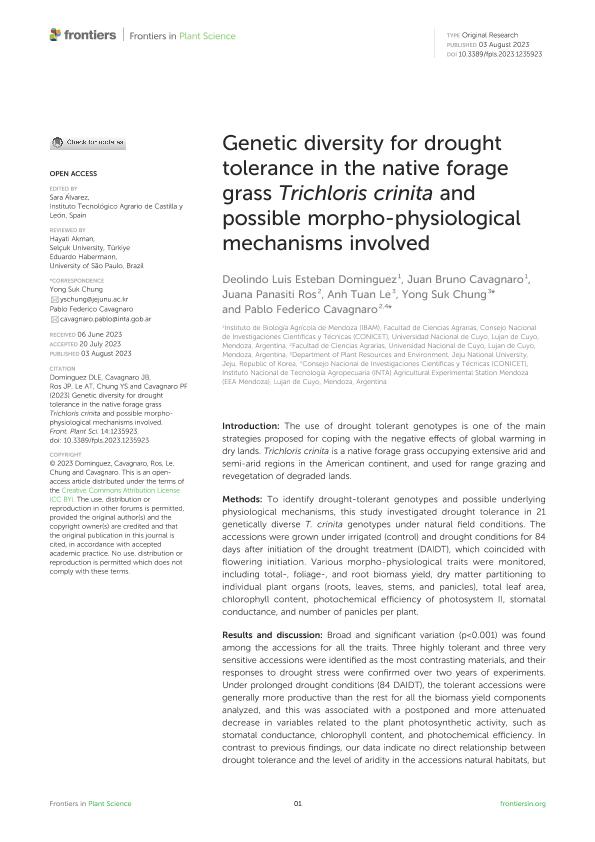Artículo
Genetic diversity for drought tolerance in the native forage grass Trichloris crinita and possible morpho-physiological mechanisms involved
Dominguez, Deolindo Luis Esteban ; Cavagnaro, Juan Bruno
; Cavagnaro, Juan Bruno ; Panasiti Ros, J.; Le, A. T.; Chung, Y. S.; Cavagnaro, Pablo Federico
; Panasiti Ros, J.; Le, A. T.; Chung, Y. S.; Cavagnaro, Pablo Federico
 ; Cavagnaro, Juan Bruno
; Cavagnaro, Juan Bruno ; Panasiti Ros, J.; Le, A. T.; Chung, Y. S.; Cavagnaro, Pablo Federico
; Panasiti Ros, J.; Le, A. T.; Chung, Y. S.; Cavagnaro, Pablo Federico
Fecha de publicación:
08/2023
Editorial:
Frontiers Media
Revista:
Frontiers in Plant Science
e-ISSN:
1664-462X
Idioma:
Inglés
Tipo de recurso:
Artículo publicado
Clasificación temática:
Resumen
The use of drought tolerant genotypes is one of the main strategies proposed for coping with the negative effects of global warming in dry lands. Trichloris crinita is a native forage grass occupying extensive arid and semi-arid regions in the American continent, and used for range grazing and revegetation of degraded lands. To identify drought-tolerant genotypes and possible underlying physiological mechanisms, this study investigated drought tolerance in 21 genetically diverse T. crinita genotypes under natural field conditions.. The accessions were grown under irrigated (control) and drought conditions for 84 days after initiation of the drought treatment (DAIDT), which coincided with flowering initiation. Various morpho-physiological traits were monitored, including total-, foliage-, and root biomass yield, dry matter partitioning to individual plant organs (roots, leaves, stems, and panicles), total leaf area, chlorophyll content, photochemical efficiency of photosystem II, stomatal conductance, and number of panicles per plant. Broad and significant variation (p<0.001) was found among the accessions for all the traits. Three highly tolerant and three very sensitive accessions were identified as the most contrasting materials, and their responses to drought stress were confirmed over two years of experiments. Under prolonged drought conditions (84 DAIDT), the tolerant accessions were generally more productive than the rest for all the biomass yield components analyzed, and this was associated with a postponed and more attenuated decrease in variables related to the plant photosynthetic activity, such as stomatal conductance, chlorophyll content, and photochemical efficiency. In contrast to previous findings, our data indicate no direct relationship between drought tolerance and the level of aridity in the accessions natural habitats, but rather suggest genetic heterogeneity and ample variation for drought tolerance in T. crinita natural populations derived from a particular location or environment. Also, having low total and forageable biomass yield, or increased biomass allocation to the roots (i.e., lower foliage/root ratio), under optimal water availability, were not associated with greater drought tolerance. The drought-tolerant accessions identified are of value for future genetic research and breeding programs, and as forage for range grazing and revegetation in arid regions.
Archivos asociados
Licencia
Identificadores
Colecciones
Articulos(CCT - MENDOZA)
Articulos de CTRO.CIENTIFICO TECNOL.CONICET - MENDOZA
Articulos de CTRO.CIENTIFICO TECNOL.CONICET - MENDOZA
Articulos(IBAM)
Articulos de INST.DE BIOLOGIA AGRICOLA DE MENDOZA
Articulos de INST.DE BIOLOGIA AGRICOLA DE MENDOZA
Citación
Dominguez, Deolindo Luis Esteban; Cavagnaro, Juan Bruno; Panasiti Ros, J.; Le, A. T.; Chung, Y. S.; et al.; Genetic diversity for drought tolerance in the native forage grass Trichloris crinita and possible morpho-physiological mechanisms involved; Frontiers Media; Frontiers in Plant Science; 14; 8-2023; 1-24
Compartir
Altmétricas



